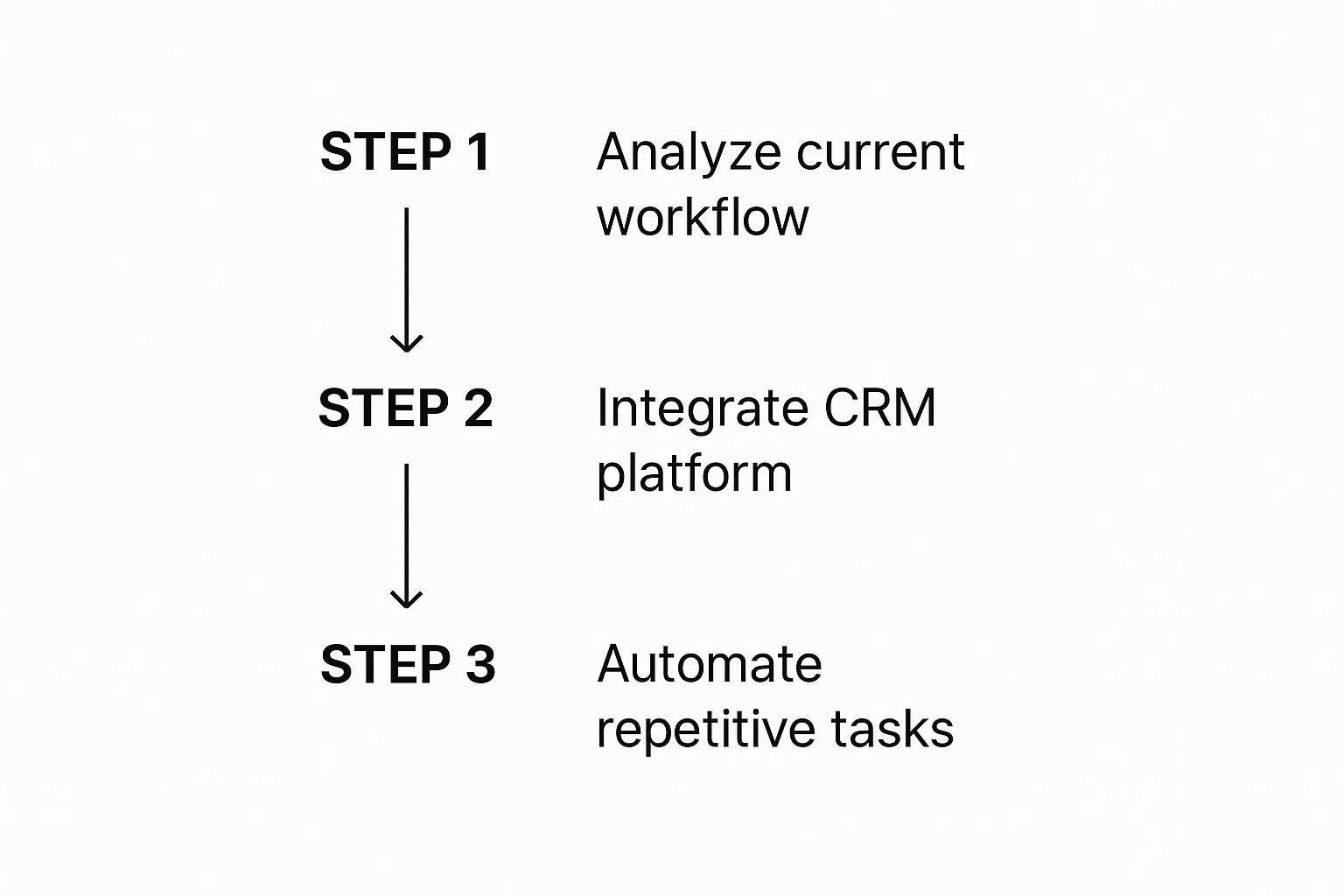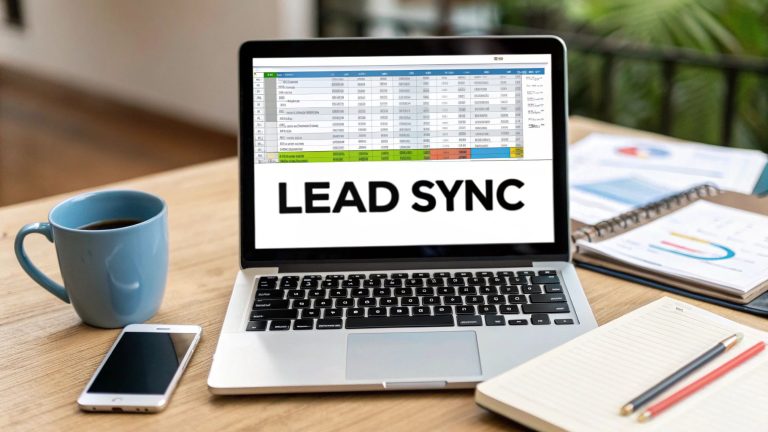How to Improve Sales Team Performance: Tips & Strategies
If you want to improve your sales team's performance, you have to stop staring at the final revenue number and start looking at the behaviors that actually produce it. It’s about shifting away from old-school metrics and taking a more honest look at what really drives results.
Move Beyond Outdated Sales Metrics
Let's be real: hitting a revenue target doesn't automatically mean your sales team is healthy. A laser focus on lagging indicators, like closed deals and quarterly quotas, can easily mask serious problems brewing just beneath the surface. This narrow view often rewards a lucky break over a solid, repeatable process.
Think about it. One of your reps lands a massive, unexpected deal and smashes their quota. On paper, they look like a rockstar. But what happens if their pipeline is bone-dry for next quarter? What if that whale was a complete one-off, not the result of a process anyone could follow? This is a trap many sales leaders fall into.
The Problem with a Rear-View Mirror Approach
Relying only on revenue is like trying to drive a car by looking exclusively in the rearview mirror. Sure, it tells you where you’ve been, but it offers zero visibility into the road ahead. In today's complex sales world, that’s just a recipe for disaster.
Selling has gotten tougher. Despite all the tech we have, only 43% of sales quotas were met on average last year. Sales cycles are also stretching out, now taking about 25% longer than they did five years ago, with deals often involving 7 to 10 decision-makers. You can dig into more eye-opening data on current sales challenges over on thunderbit.com. These numbers prove one thing: you need a resilient, process-driven team to even stand a chance.
From What to How
The most effective leaders shift their focus from what their team achieves to how they achieve it. The key to improving sales team performance is to dig into the daily activities and habits that build a healthy pipeline and lead to predictable wins.
The goal isn't just to hit this month's number. It's to build a system where hitting future numbers is the natural result of your team’s consistent, high-quality work.
This means you start prioritizing leading indicators—the forward-looking metrics that actually predict future success. When you focus on the how, you build a team that doesn't just get lucky. They manufacture their own success through skill, discipline, and a bulletproof process.
A truly high-performing team is built on a foundation of strong, repeatable habits. Here are the core areas where that foundation is laid:
- Pipeline Generation: Are reps consistently adding qualified opportunities to the funnel?
- Activity Quality: Are discovery calls actually uncovering deep-seated pain points, or are they just surface-level chats?
- Process Adherence: Is CRM data clean? Are deal stages updated accurately and on time?
- Conversion Rates: Where are deals getting stuck? Pinpointing the weak spots in your sales cycle is critical.
By keeping a close eye on these elements, you can spot problems before they blow up a whole quarter. You’ll know which reps need coaching on prospecting and which ones are struggling to close, allowing you to provide targeted help that actually moves the needle. This is the first, most critical step in building a team that wins for the long haul.
Transform Managers Into Elite Sales Coaches
What’s the single biggest lever you can pull to boost your sales team’s performance? It’s not a fancy new CRM feature or a bigger travel budget. It’s your sales managers.
Too many managers are drowning in administrative work, acting more like glorified scorekeepers than the performance multipliers they should be. To see real results, you have to get them out of the reports and into developing their people.
A genuine coaching culture isn't built on micromanagement or stressful pipeline interrogations. It’s built on trust, personalized guidance, and a real investment in each rep's success.
The difference is staggering. Top-performing sales reps are 83% more likely to say their managers provide effective support. The impact is even more dramatic for new hires. Sellers with less than five years of experience are 240% more likely to become top performers when they have an effective manager guiding them. This isn't just a nice-to-have; it's a core strategy for building a team that wins.
From Pipeline Interrogations to Strategy Sessions
One of the fastest ways to kill morale is turning a one-on-one into a grilling session about the pipeline. When a manager's only questions are, "Is this deal going to close?" or "Why hasn't this moved?" they're adding pressure without adding any value.
An elite coach completely flips this conversation. Instead of just inspecting the pipeline, they help reps strategize within it. The meeting shifts from an interrogation to a collaboration.
Here’s what that sounds like in the real world:
- Instead of: "Why is this deal stalled?"
- Try: "Walk me through your last conversation with the champion. What are their top priorities right now, and what can we show them to create some urgency?"
- Instead of: "Are you sure you can close this by Friday?"
- Try: "What are the biggest risks to this deal, and how can we get ahead of them together? Is there anyone else on their team we should be talking to?"
This simple shift in framing turns a dreaded meeting into a valuable working session. The rep walks away feeling supported and more confident, not defensive.
Delivering Feedback That Builds People Up
Constructive feedback is critical, but how you deliver it determines whether it inspires growth or creates resentment. A classic mistake is the "praise sandwich," where you awkwardly stick criticism between two compliments. Reps see right through it, and it feels insincere.
A much better approach is direct, specific, and focused on behavior. You're coaching the action, not criticizing the person.
Key Takeaway: The goal of feedback isn't to point out what's wrong. It's to collaboratively build a plan for what "right" looks like next time.
For instance, after reviewing a call recording, don't just say, "You need to be more assertive." That's not helpful. A great coach gets specific: "I noticed when the prospect brought up budget, we immediately offered a discount. Next time, let's try digging deeper first. Ask something like, 'Help me understand how you've budgeted for initiatives like this in the past.' That way, we re-establish value before we talk price."
This gives the rep a clear, actionable play for their next call. It’s empowering. To truly make this happen, managers must embrace the critical role of managers as coaches and mentors.
Ultimately, a manager's success isn't measured by the reports they file. It’s measured by the growth they spark in their people. When you make coaching a daily habit, you build a resilient, skilled, and motivated sales force that can blow past its goals.
Build Motivation and Incentives That Drive Results

If your only tool for motivating the sales team is a bigger commission check, you're playing a losing game. It’s a common trap. We assume every rep is purely "coin-operated," but that old stereotype just doesn't hold up anymore. Relying only on cash is a short-sighted strategy that misses what really drives long-term performance.
A truly energized team runs on more than just money. They need recognition, a clear path for growth, and to feel like their work actually matters. When you ignore these deeper, more human motivators, you're leaving a massive amount of effort and passion on the table. This can lead to burnout, even for your top earners.
You have to build a culture of motivation—an environment where your reps feel seen, valued, and genuinely invested in their own success.
Think Beyond the Bonus Check
Let's be real: non-monetary rewards often have a much bigger and more lasting impact than a temporary cash bonus. Why? Because they show you’re actually paying attention to the hard work that happens long before a deal ever closes. When you celebrate the right behaviors, you reinforce the exact habits that lead to predictable wins.
Here are a few powerful non-monetary incentives that actually work:
- Public Recognition: A simple, genuine shout-out in a team meeting or a company-wide email can be incredibly motivating. Acknowledge a rep who ran a phenomenal discovery call or has kept their CRM data pristine. It shows you notice the details.
- Career Pathing: Show your reps a clear path forward. What does it take to become a senior account executive? A team lead? When people can see a future for themselves at the company, they’re far more motivated to deliver in the present.
- Extra Time Off: Reward a top performer with an extra PTO day. This kind of reward champions work-life balance and proves you care about their well-being, which is often way more valuable than a small bonus.
- Access to Leadership: Arrange a lunch or a one-on-one with a C-suite executive. This gives reps a chance to share their on-the-ground insights and feel like a valued part of the bigger picture.
The most effective incentives don't just reward the final outcome; they reward the process. By celebrating the small wins along the way, you build the momentum that leads to bigger victories.
This isn't just fluffy stuff; it requires real leadership skill. In fact, research shows that sales managers who are great at leading coaching meetings are 40% more common among high-performing teams. Those same managers are also 71% more likely to effectively motivate their sellers.
Align Incentives with the Right Behaviors
Your compensation plan is a giant billboard telling your team what you truly value. If you only pay out for closed deals, reps will focus exclusively on closing—even if it means cutting corners on prospecting, discovery, or qualification.
To really improve sales team performance, you have to align your incentives with the activities that build a healthy pipeline and a sustainable business.
Consider structuring part of your incentives around leading indicators of success. This could mean offering a small bonus for hitting specific activity goals that directly fuel future revenue. If you want to go deeper on this, check out our guide on how to improve sales productivity by focusing on key activities.
Think about rewarding reps for hitting targets like:
- Setting a specific number of qualified meetings with ideal customer profile (ICP) accounts.
- Generating a certain amount of new, qualified pipeline value each month.
- Achieving a high lead-to-opportunity conversion rate.
- Maintaining 95% accuracy in CRM data for their open deals.
This approach accomplishes two critical things. First, it gives reps a way to "win" and earn recognition even during a slow closing month, which keeps morale from tanking. And second, it directly encourages the very behaviors that prevent those slow months from happening in the first place. It’s a win-win.
Fine-Tune Your Sales Process and Tech Stack
Even the best sales reps will stumble if they're stuck in a clunky, inefficient sales process. When your team spends more time battling administrative tasks than actually selling, you're not just losing deals—you're burning out your top performers. A smooth workflow isn't just a nice-to-have; it's the engine that drives a high-performing sales team.
Think about it: reps spend nearly 28% of their week on non-selling activities like internal meetings and admin work. That's more than a full day, every single week, that could have been spent building relationships and closing deals. To get that time back, you need to audit your entire process from lead intake to final signature, hunting down every bottleneck that slows you down.
A critical part of this is sales process optimization. This means mapping out every stage of your sales cycle and defining crystal-clear rules for when a deal moves from one stage to the next. When everyone on the team knows exactly what needs to happen to push a deal forward, you eliminate confusion and build momentum.
Using Technology as a True Enabler
Once your process is clearly mapped out, you can start layering in technology to support it. The goal isn’t to pile on more tools for the sake of it. Instead, you want to use technology to automate the boring, low-value tasks and give your reps the insights they need to sell smarter. The right tech stack should feel like a superpower, not another burden.
The image below gives a simple framework for how to think about this.

The key takeaway? Technology should always follow your process, not the other way around. First, analyze your workflow. Then, integrate a core platform like a CRM to automate the tasks that are bogging your team down. This frees them up to focus on high-impact selling activities.
A modern tech stack isn't about having the most tools; it’s about having the right tools that work together seamlessly.
A well-built tech stack gives your reps their most valuable resource back: time. By automating repetitive work, you empower them to focus on what humans do best—building rapport, understanding customer needs, and solving complex problems.
For example, your CRM should be the single source of truth for every customer interaction. When set up correctly, it can automatically log emails and calls, track deal progress, and give managers a real-time view of pipeline health. This means reps aren't wasting hours manually updating spreadsheets, and leaders get the data they need to provide effective coaching. For a deeper dive, check out our guide with more sales pipeline management tips that can help you optimize this flow.
Auditing and Optimizing Your Current Stack
Does your team have tool fatigue? It's a real and growing problem. Over a third of employees say they use too many different tools, which ends up hurting productivity instead of helping it. A regular audit of your tech stack is non-negotiable.
Here are a few critical questions to ask your team:
- Which tools are you actually using every single day?
- What tasks are eating up the most manual effort and time?
- Are we paying for different software that does the same thing?
- What information do you wish you had at your fingertips during a sales call?
Their answers will quickly show you what’s working and what’s just creating noise. Your mission is to build a lean, integrated system where data flows effortlessly between tools, from the moment a lead is captured to the final customer handoff.
This kind of setup gives your reps a 360-degree view of the customer, allowing for much more meaningful and personalized conversations. Ultimately, a clean process supported by smart tech is the foundation for repeatable, scalable success.
To help you connect the dots between your team's challenges and potential solutions, this table maps common sales bottlenecks to the types of technology that can fix them.
Mapping Sales Challenges to Technology Solutions
| Sales Challenge | Potential Technology Solution | Key Feature to Look For | Impact on Performance |
|---|---|---|---|
| Manual Data Entry & Logging | Customer Relationship Management (CRM) | Automated activity capture (emails, calls) | Frees up 5+ hours per rep weekly |
| Inconsistent Follow-up | Sales Engagement Platform | Automated email/SMS sequences | Ensures timely outreach, improves response rates |
| Wasted Time on Unqualified Leads | Lead Scoring Software | Predictive scoring based on behavior & demographics | Focuses effort on high-intent buyers, boosts conversion |
| Difficulty Scheduling Meetings | Appointment Scheduling Tool | Integrated calendar with one-click booking links | Reduces back-and-forth emails, accelerates sales cycle |
| Lack of Insight During Calls | Conversation Intelligence Software | Real-time talking points and competitor mentions | Improves rep confidence and objection handling |
By identifying your team's biggest time-wasters and aligning them with the right tools, you can systematically remove friction from their day. This not only makes them more productive but also improves morale by letting them focus on what they do best: selling.
Track Performance Metrics That Actually Matter

You can't fix what you don't measure. And if you’re only looking at total revenue, you’re flying blind. To really get a grip on sales productivity, you have to look past the final number and dig into the metrics that show you what’s happening right now.
It all comes down to understanding two types of metrics: lagging indicators and leading indicators.
Think of lagging indicators (like quarterly revenue or quota attainment) as the final score of a game. They’re important, sure, but they only tell you what already happened. You can't change the outcome.
Leading indicators, on the other hand, are the in-game stats. They're predictive, giving you a real-time pulse on your team's health so you can make coaching adjustments before a problem tanks the whole quarter.
Moving From Lagging To Leading Indicators
Relying on leading indicators is like a doctor checking a patient's vitals—it helps you spot trouble before it becomes an emergency. If a rep's pipeline is looking thin or their deals are slowing down, you can step in with targeted coaching immediately. The alternative is waiting three months to find out they missed their number.
This data-first approach takes the guesswork out of management and turns you into a strategic coach. Beyond just sales numbers, it’s worth exploring proven methods for measuring team performance to get a complete picture of your team's effectiveness.
Here are the essential leading indicators I recommend every sales manager track:
- Pipeline Velocity: How fast are deals moving from one stage to the next? A slowdown is a red flag. It might point to friction in your process or a need for better objection-handling skills.
- Stage-by-Stage Conversion Rates: What percentage of deals make it from Discovery to Demo? How about from Demo to Proposal? Seeing where deals die on the vine tells you exactly where your team needs help.
- Average Deal Size: Is this number trending up or down? If it's shrinking, your reps might be giving away discounts too easily or missing upsell opportunities.
- Activity Volume & Quality: It’s not just about how many calls are made. The real question is: are those activities actually turning into qualified meetings?
Key Insight: Tracking leading indicators changes your entire coaching conversation. Instead of asking, "Are you going to hit your number?" you can say, "I see your lead-to-opportunity conversion rate dropped this week. Let's listen to your discovery calls and figure this out together."
Building a Diagnostic Sales Dashboard
A great sales dashboard does more than just show you data; it tells you a story. It should give you an at-a-glance view of who’s crushing it and who’s starting to struggle.
For example, if you see a rep with a ton of activity but very few meetings booked, that's a crystal-clear sign. They need coaching on their opening pitch and value proposition. This is the kind of insight that stops reps from spinning their wheels and boosts morale. For more on what to track at the top of the funnel, check out our guide on https://leadsavvy.pro/post/lead-generation-performance-metrics/.
Let's be real about B2B sales. The average win rate hovers around a brutal 20-21%, and it can take anywhere from five to twelve follow-ups to get a deal done. Worse, only 1-2% of all B2B leads will ever become a sale. This is why tracking those early-stage conversions and the quality of your team's outreach is so critical for any long-term success.
When you start tracking the metrics that actually matter, you give yourself the power to make smart, proactive decisions. You stop reacting to past failures and start engineering future wins.
Answering Your Sales Performance Questions

As you start rolling out these new strategies, questions are bound to pop up. It's totally normal. Improving a sales team isn't a one-and-done project; it's a living, breathing process.
This section tackles the most common questions I hear from sales leaders. Think of it as a quick guide to help you manage expectations and make the right calls as you push for better performance.
How Long Until I See Real Improvement in Sales Performance?
This is the big one, isn't it? The answer really has two parts. You'll probably see some quick wins in your leading indicators within just a few weeks. This means things like better CRM data, more consistent prospecting, and reps running sharper discovery calls. These are the early green shoots telling you the new habits are taking root.
But for the heavy hitters—the lagging indicators like quota attainment and overall win rates—you need to be more patient. Realistically, you won't see a major shift until after a full sales cycle, which for most businesses is somewhere between 3 to 6 months.
The goal isn't just speed; it's consistency. A sudden push might cause a temporary spike, but it's the daily grind of coaching and sticking to the process that builds lasting results. Look for sustained progress, not an overnight miracle.
One great month is nice, but a full quarter of solid, sustained improvement is the real proof that your changes are working. Celebrate those small wins to keep the team fired up, but keep your eyes on the long-term prize.
What Is the Single Biggest Factor for Boosting Sales Team Morale?
It's tempting to think it's all about the money, but it's not. While competitive pay is a must-have, the single most critical factor for morale is creating a culture of psychological safety and a clear path to success.
It’s about building an environment where reps feel supported, competent, and genuinely believe they have what it takes to win. When your team feels safe, they’re not afraid to ask for help, try new things, or own up to mistakes. That’s where real growth happens.
This kind of environment is built on a few key pillars:
- Transparent Leadership: Being open about the "why" behind your goals and decisions.
- Achievable Goals: Setting targets that are tough but feel fair and within reach.
- Recognition for Effort: Celebrating the right behaviors and hard work, not just the closed-won deals.
- Invested Management: A manager who is a coach and an advocate, not just a taskmaster.
When a rep feels like their manager is truly in their corner, invested in their growth, their drive goes through the roof. That feeling of being valued beats a one-time bonus any day of the week.
Should We Hire A-Players or Develop Our Current Team?
I get this question all the time. The best answer is a bit of both, but your primary focus should always be on developing the team you already have. Trying to build a team by only hiring superstar "A-players" is a risky and expensive game.
What happens when that rockstar leaves? Your whole strategy falls apart. The most resilient and cost-effective approach is to build a system—a performance engine—that can reliably turn your B-players into A-players. A strong coaching culture does exactly that.
Plus, when you get a reputation for investing in your people, you become a magnet for talent. The best reps want to work for leaders who will help them level up their skills and career. Suddenly, your recruiting pipeline gets a whole lot stronger.
A great system will always outperform a few great individuals. Even a top-tier A-player will flounder if they land in a broken process with zero support. Build the machine first.
This investment in development has a massive payoff. The best sales managers are 67% more confident in their ability to help their sellers hit their numbers and 51% more likely to coach them regularly. As you can see in these sales leadership statistics, investing in well-trained, proactive leadership is one of the most powerful moves you can make.
Stop wasting time on manual CSV downloads and start converting leads faster. With LeadSavvy Pro, you can instantly sync Facebook leads to your Google Sheet or CRM and get notified the moment they arrive. Get started for free with LeadSavvy Pro today and see how effortless lead management can be.







